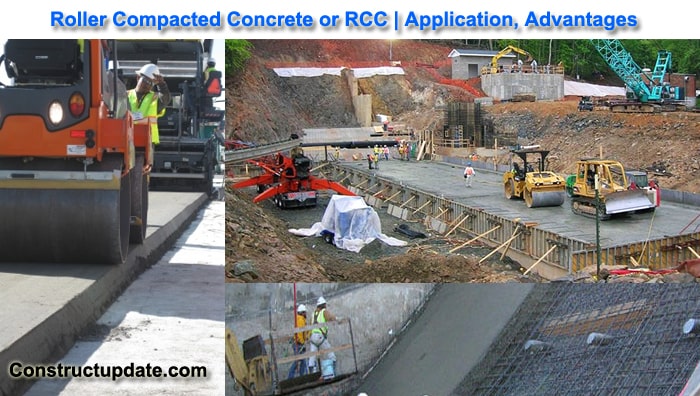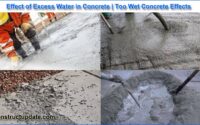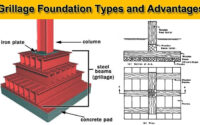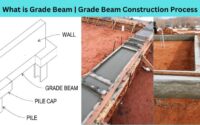Roller Compacted Concrete or RCC | Application, Advantages and Benefits
What is Roller Compacted Concrete (RCC)
The name “roller-compacted concrete,” or RCC, comes from the manner of construction. It’s laid down with standard or high-density asphalt paving equipment and then compacted with rollers.
Cement, water, and aggregates, such as gravel or crushed stone, are the same essential ingredients in roller-compacted concrete as in traditional concrete.
However, unlike traditional concrete, it’s a drier mix that may be compressed using vibratory rollers. RCC is usually built without any joints. It doesn’t require any forms or finishing, and it doesn’t have any dowels or steel reinforcing.
Materials, Production, and Placement
Cement, water, and aggregates, such as gravel or crushed stone, are the same essential ingredients in roller compacted concrete as in traditional concrete. Unlike ordinary concrete, however, the slurry is drier and rigid enough to be compacted with a vibratory roller.
RCC mixes typically contain a high percentage of stone, Portland cement with fly ash as a substitute, a small amount of sand, and, of course, water to hydrate the mix.
The roller compacted concrete mixture must be dry enough to prevent the vibratory roller equipment from sinking, yet moist enough to allow adequate distribution of the binder mortar in the concrete during mixing and vibratory compaction.
Earth and rockfill construction machinery is used to carry, lay, and compact roller compacted concrete.

Benefits of Roller Compacted Concrete:
Roller compacted concrete pavements have a high strength that eliminates the usual and costly difficulties associated with asphalt pavements.
- Concrete that has been roller compacted has a lot of strength.
- There is no need to use forms with roller compacted concrete.
- Rebar is not required in this roller-compacted concrete.
- Concrete that has been roller compacted is a high volume application.
- It may be utilised as a road in as little as 24 hours and is unaffected by oil spills, fuels, or hydraulic fluids.
- Span subgrades with soft, localised subgrades
- High-temperature resistance
Advantages of Roller Compacted Concrete (RCC):
- The production of this roller compacted concrete is both cost-effective and quick.
- Roller compacted concrete requires very little upkeep.
- There is no rutting or potholes on the roller compacted concrete surface.
- The layer placement method reduces or eliminates the cost of formwork.
- Under severe concentric loads, roller compacted concrete does not deform.
- Reduces cement usage by allowing for the use of leaner concrete mixtures.
- The discharge of excessive heat during the drying of concrete is not an issue.
- Resistance to shoving and pushing with roller compacted concrete.
- As a result, the concrete will be handled by dump trucks, disseminated by bulldozers, and compacted by vibration rollers to save money on transportation, placement, and compaction.
Roller Compacted Concrete Disadvantages:
- It’s difficult to achieve smoothness.
- Cracks are being revealed.
- A skilled individual is necessary.
Because the earth fill method employed in roller compacted concrete dams does not easily handle such a construction, the drainage gallery often increases construction time and expenses.
When aggregate material is not readily available, the foundation rock is of poor quality or not close to the surface, or foundation conditions can lead to severe differential settling, Roller Compacted Concrete may not be acceptable.
Water seepage may occur in dams built or repaired with roller-compacted concrete. As a result, water stoppage layers must be taken into account.
Application of Roller Compacted Concrete:
RCC is now employed when strength, rapidity of construction, durability, and cost are the most important factors. It’s a sort of concrete pavement that’s ideal for large industrial uses as well as low-speed and arterial routes. The following structures have been built, repaired, or maintained with roller compacted concrete:
- New dam construction
- Rehabilitation of existing dams
- Airports
- Industrial and military facilities
- Storage Construction
- Ports Construction
- Sub-base of roads and airfield pavements
- Multi-modal yards construction
- Construction of Distribution centers
- Parking and storage facilities Construction
- Streets & highways, intersections, shoulders, turn lanes, bike paths
- Manufacturing facilities, heavy haul roads, scrap yards
- Power plants and other industrial facilities
- Over-topping protection
- Reservoir liners
- Industrial slab floors
- Airfield maintenance areas




